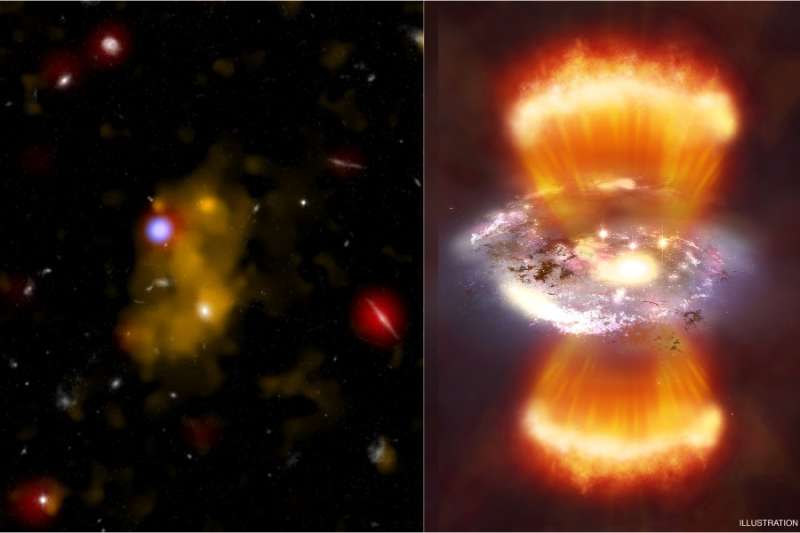Credit & Copyright: NASA/CXC/M.Weiss
Explanation:
Dubbed a Lyman-alpha blob, an enormous cloud of hydrogen gas spans
several hundred thousand light-years in
this remarkable
image (left), a composite of
x-ray, optical,
and infrared data
from space and ground based observatories.
The gigantic, amoeba-like structure is seen as it was when
the universe was a
mere 2 billion
years old (about 12 billion
years ago).
Lyman-alpha blobs are so called because they strongly emit
radiation due to the
Lyman-alpha emission
line of hydrogen gas.
Normally, Lyman-alpha emission is in the ultraviolet part of
the spectrum, but Lyman-apha blobs are so distant, their light is
redshifted to (longer) optical
wavelengths.
X-ray data (blue)
indicates the presence of a
supermassive black hole
feeding at the center of an active galaxy embedded in the blob.
Illustrated close up in the right hand panel, radiation and outflows
from the active galaxy are thought to be a source for energizing
and heating the blob's hydrogen gas.
In fact, Lyman-alpha blobs could represent an early phase in
galaxy formation where the heating is so great it begins
to limit further rapid growth of
active
galaxies and their supermassive black holes.
1999 2000 2001 2002 2003 2004 2005 2006 2007 2008 2009 2010 2011 2012 2013 2014 2015 2016 2017 2018 2019 2020 2021 2022 2023 2024 2025 |
Yanvar' Fevral' Mart Aprel' Mai Iyun' Iyul' Avgust Sentyabr' Oktyabr' Noyabr' Dekabr' |
NASA Web Site Statements, Warnings, and Disclaimers
NASA Official: Jay Norris. Specific rights apply.
A service of: LHEA at NASA / GSFC
& Michigan Tech. U.
|
Publikacii s klyuchevymi slovami:
hydrogen - lyman alpha - emission line - supermassive black hole - multiwavelength - redshift - Laiman-al'fa - aktivnaya galaktika - krasnoe smeshenie
Publikacii so slovami: hydrogen - lyman alpha - emission line - supermassive black hole - multiwavelength - redshift - Laiman-al'fa - aktivnaya galaktika - krasnoe smeshenie | |
Sm. takzhe:
Vse publikacii na tu zhe temu >> | |
